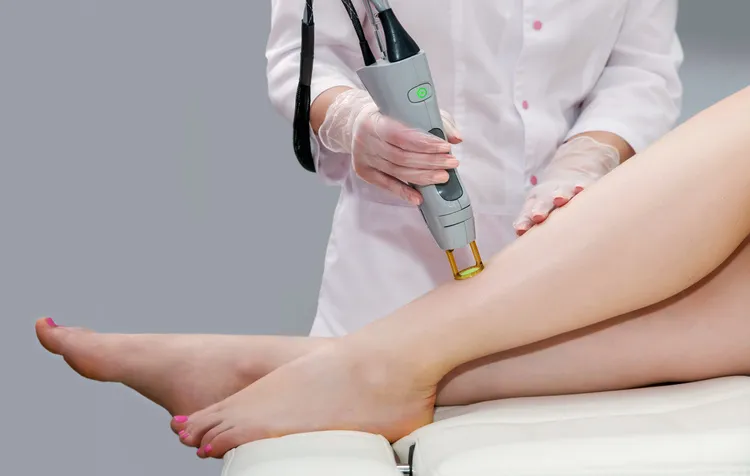The Science Behind Laser Hair Removal : Kaya Clinic

Introduction
Laser hair removal is heralded as one of the most effective and advanced methods for reducing unwanted body hair. This technology harnesses the power of light to offer a semi-permanent solution to hair growth, providing a smooth, hair-free complexion over time. Understanding the scientific principles that underpin laser hair Reduction can help demystify the process and highlight why it has become a preferred choice for many seeking long-term hair reduction solutions.
The Basics of Laser Technology in Hair Reduction
Laser hair removal utilizes specific wavelengths of light aimed at targeting the melanin (the pigment that gives hair and skin its color) within hair follicles. The fundamental science behind this method is selective photothermolysis, a process where a specific wavelength of light is matched to the target area with minimal effect on surrounding tissues. The laser emits a concentrated beam of light, which is absorbed by the pigment in the hair follicle. As the melanin heats up, it damages the follicle’s ability to regenerate, eventually leading to the reduction of hair growth.
Types of Lasers Used in Hair Removal
Different types of lasers are used in hair Reduction, each suited to different skin types and hair colors. The most commonly used lasers include:
- Alexandrite Laser: Best for treating larger body areas in patients with light to olive complexions, this laser operates at a 755 nm wavelength, which is very effective at targeting melanin.
- Diode Laser: Featuring a longer wavelength of 810 nm, this type is particularly effective for darker skin tones, as it penetrates deeper into the skin, minimizing damage to the epidermis.
- Nd
Laser: With a wavelength of 1064 nm, this laser can treat all skin types, including tanned skin. It’s less absorbed by melanin, making it suitable for darker skin but potentially less effective on fine or light hair.
- Intense Pulsed Light (IPL): While not a traditional laser, IPL uses a broad spectrum of light with multiple wavelengths, making it versatile but less specific in targeting melanin.
How Laser Targets Hair Growth
Hair growth occurs in three stages: anagen (growth phase), catagen (transitional phase), and telogen (resting phase). Laser hair removal is most effective during the anagen phase, as this is when the hair contains an abundance of melanin, providing a clear target for the laser. Because not all hairs are in the same phase at the same time, multiple sessions are required to effectively reduce hair growth across an area.
The Role of Melanin in Laser Hair Removal
Melanin’s role is crucial as it’s the chromophore that the laser targets in the hair follicle. The effectiveness of laser hair removal largely depends on the contrast between the skin color and the hair color. Higher contrasts (light skin and dark hair) typically yield the best results because the laser can selectively target the dark hair without affecting the lighter skin. Technological advancements have made laser hair Reduction safer and more effective for patients with darker skin tones, where melanin absorption can be a concern.
Optimizing Laser Hair Removal Effectiveness
Several factors contribute to the effectiveness of laser hair Reduction:
- Pre-treatment care: Avoiding sun exposure, not plucking or waxing the area, and shaving the day before treatment can enhance effectiveness.
- Post-treatment care: Cooling the skin and avoiding sun exposure help in reducing side effects and enhancing the healing process.
- Tailored treatment plans: Adjusting the laser settings according to skin and hair type, color, and area size is essential for achieving optimal results.
Safety and Regulatory Aspects
Laser hair removal is widely considered safe when performed by a qualified and experienced practitioner. It is FDA-approved, and the technology is continuously refined to improve safety and efficacy. Side effects are typically minor and temporary, including redness, irritation, and pigment changes, especially if post-care guidelines are followed carefully.
Technological Advances in Laser Hair Reduction
The field of laser hair Reduction is continuously evolving, with innovations aimed at improving comfort, reducing treatment times, and enhancing safety. Newer models can now treat a wider range of skin and hair types, offer more precise energy settings, and incorporate cooling mechanisms to protect the skin and reduce discomfort during treatment.
Conclusion
The science behind laser hair Reduction is both fascinating and complex, involving precise technology designed to selectively target hair follicles without damaging surrounding skin. Its continued refinement and success in providing a long-term solution for unwanted hair growth ensure its place as a cornerstone in cosmetic dermatology. With each technological advancement, laser hair removal becomes more inclusive, effective, and safe, offering millions the chance to enjoy the confidence that comes with clear, smooth skin.
1. Is laser hair Reduction safe?
Laser hair removal is considered safe when performed by a trained and certified professional. It is FDA-approved for the permanent reduction of hair growth. The primary risks include temporary discomfort, redness, and swelling. Rare side effects can include blistering, discoloration of the skin, and scarring. Advanced cooling systems in modern lasers help minimize risks and enhance comfort during the procedure. It’s crucial to follow all pre- and post-treatment care instructions and choose a reputable clinic to further ensure safety.
2. How long does each laser hair Reduction session last?
The duration of a laser hair removal session can vary widely depending on the size of the area being treated. Small areas like the upper lip may take a few minutes, while larger areas such as the back or legs might require an hour or more. The speed of the session also depends on the type of laser technology being used, as some newer models are designed to operate faster with less discomfort.
3. Can laser hair Reduction eliminate hair permanently?
Laser hair removal significantly reduces hair growth, but it does not guarantee permanent elimination. Most people experience substantial and lasting reduction, but hair follicles that are dormant during treatment can later become active. Periodic maintenance treatments may be necessary to keep the area free of hair. The number of sessions and the effectiveness of the treatment can vary based on individual factors like hair color, skin type, and the life cycle of hair follicles.
4. What should I avoid doing before a laser hair Reduction session?
Before undergoing laser hair removal, you should avoid sun exposure for at least six weeks to avoid tan lines, which can affect the effectiveness of the treatment and increase the risk of side effects. Additionally, you should not pluck, wax, or undergo electrolysis in the weeks leading up to the treatment because these methods remove the hair root, which is necessary for the laser to target.
5. Can I go in the sun after laser hair removal?
It’s best to avoid direct sunlight on the treated area for at least a week after a laser hair removal session. Sun exposure can increase the risk of skin pigmentation changes after treatment. If you must be in the sun, use a broad-spectrum sunscreen with an SPF of 30 or higher to protect the treated skin.
6. How should I care for my skin after laser hair Reduction?
After laser hair removal, treat the skin gently. Avoid any harsh skin treatments in the treated area for at least a week. Keep the skin moisturized and avoid sun exposure. If the skin is irritated, applying a cool compress or aloe vera may help soothe it. Avoiding hot showers and chlorine (from swimming pools) for a couple of days can also prevent irritation.
7. What are the possible side effects of laser hair removal?
The most common side effects include slight redness and swelling of the follicles, which are temporary and typically subside within a few hours to days. Other possible side effects include itching, temporary pigment changes (especially in individuals with darker skin), and, rarely, blistering or scarring. Adhering to pre- and post-care instructions can help minimize these risks.
8. Who is not a good candidate for laser hair Reduction?
Individuals with very light or white hair may not be ideal candidates because the laser targets melanin, which light hair lacks. People with very dark skin are also challenging to treat due to the melanin in the skin absorbing some of the laser’s energy intended for the hair follicles. Pregnant women are generally advised to postpone treatment due to the lack of safety data.
9. Does laser hair removal cause pain?
The pain associated with laser hair removal is generally mild and often compared to the snap of a rubber band against the skin. Discomfort can vary depending on the treatment area and the patient’s pain tolerance. Many modern laser machines feature cooling mechanisms that help minimize discomfort, and topical numbing creams can also be applied before treatment to reduce pain.
10. What types of lasers are used in hair removal?
Several types of lasers are commonly used for hair removal, including:
- Alexandrite lasers, which are effective for lighter skin types.
- Diode lasers, suitable for all skin types.
- Nd
lasers, which are best for treating darker skin types because they have a longer wavelength that bypasses the melanin in the skin’s surface.
- Intense Pulsed Light (IPL), which is not a laser but uses similar technology to target hair pigments.
11. How do I choose a laser hair Reduction provider?
Selecting a qualified and experienced laser hair removal provider is crucial. Look for a provider who is licensed and certified in laser treatments. It’s beneficial to choose a provider with experience treating your specific skin type and hair color. Reading reviews, asking for referrals, and consulting with the provider to assess their knowledge and professionalism can help ensure a safe and effective treatment experience.
12. Can laser hair removal be done on any part of the body?
Yes, laser hair removal can be effectively performed on almost any part of the body. The most common areas include the legs, arms, bikini line, back, face, and underarms. Each area can respond differently to treatment, depending on the thickness of the hair and skin type.
13. What is the best time of year to undergo laser hair Reduction?
Many practitioners recommend starting laser hair removal treatments during the fall or winter. This timing allows the skin to heal without the increased sun exposure. That occurs in the summer months, reducing the risk of side effects like pigmentation changes. Also, it prepares the skin to be smooth and hair-free by the summer.
14. Can men undergo laser hair Reduction?
Absolutely, laser hair removal is just as effective on men as it is on women. Common areas for treatment on men include the back, chest, shoulders, and abdomen. The process works the same way, targeting the pigment in the hair follicle to reduce hair growth.
15. What advancements have been made in laser hair Reduction technology?
Recent advancements in laser hair removal technology include the development of more sophisticated cooling devices to reduce discomfort during treatment, as well as improvements in laser precision and effectiveness. Newer laser models can safely treat a wider range of skin types and hair colors with greater efficacy. Additionally, some newer lasers are capable of faster treatment times, making it easier to treat larger areas.
Related Blog : Laser Hair Removal Guide






